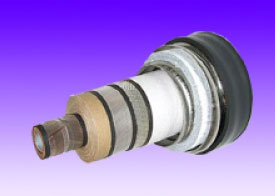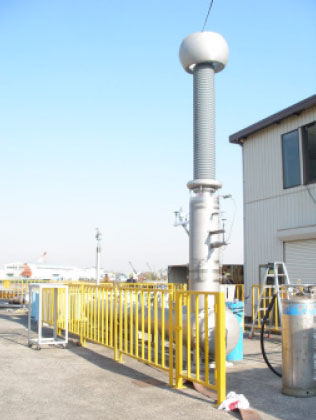June 21, 2011
Furukawa Electric has developed a 275kV superconducting power cable of the highest voltage class in the world.
Utilizing the Yttrium-based superconducting wires, which boast excellent cost performance, the superconducting power cable has doubled the voltage performance and tripled the power performance of conventional cables through improving the technologies for conversion to cable. It has also halved the AC loss of conventional cables, enabling massive amounts of electricity to be carried with low loss.
These results were achieved through the “Technology development project of the Yttrium-based superconducting power device (Project leader: Yuh Shiohara, Director General of the International Superconductivity Technology Center)” commissioned by the New Energy and Industrial Technology Development Organization (NEDO).
Developmental Background

Photograph of superconducting power cable
As a superconducting power cable (Note 1) is capable of carrying massive amounts of electricity with low loss, it is expected to bring about a large-capacity yet compact cable that cannot be achieved using conventional technology, as well as making a significant contribution to energy savings and the reduction of CO2 emissions. Particularly because the larger the transmission capacity, the greater the energy-saving effect, it is currently under development to become a backbone transmission line for carrying electricity from power plants to the point of consumption.
The most common backbone transmission line is 275kV in Japan, while it is 220kV overseas. However, the voltage class of the superconducting power cables that had been developed so far was 66kV in Japan and a maximum of 138kV overseas, so it was imperative to develop a superconducting power cable that could withstand high voltages.
Furukawa Electric is undertaking the development of a 275kV superconducting power cable system, with the aim of introducing it on a full-scale basis in 2020, through the “Technology development project of the Yttrium-based superconducting power device,” which was launched in FY2008. We have succeeded in raising the voltage of a superconducting power cable and in developing a 275kV outdoor termination (Note 2), which were the important technical issues associated with the above project. We have also managed to halve the AC loss in order to reduce CO2 emissions.
Features of the Developed Product and Data Specifications
- Development of the world’s largest capacity superconducting power cable
- The superconducting power cable quadrupled the domestic development result of 66kV and doubled the international development result of 138kV.
- The superconducting power cable achieved a transmission capacity of 1.5 million kW (275kV 3,000A), which is three times greater than the conventional capacity, enabling the transmission of the power generated by one thermal power station with a single line of superconducting power cables.
- Achievement of the world’s smallest AC loss (Note 3)
- The superconducting power cable achieved an AC loss of 0.12 W/m (50% of the previous world record of 0.23 W/m) in current loading of 3kA.
- The superconducting power cable can reduce power transmission loss to 25% of that of conventional CV cables.
- Development of the world’s first 275kV outdoor termination
- Adopting a composite hollow insulator (Note 4) with a number of advantages including light weight, anti-fouling performance, explosion resistance and workability in terms of assembly, this outdoor termination is lighter and more compact, with 20% less weight and 80% less length than the conventional outdoor termination utilizing porcelain shells.
- The termination and the superconducting cable have passed an AC voltage test of 400 kV and an impulse voltage test of 1155 kV, and have proven tolerance to constant AC current loading of 3 kA.
The result of this research will be presented at Jicable'11 - 8th International Conference (Note 5) to be held in Versailles, France from June 20.
Glossary
(Note 1)Superconducting power cable:
A superconducting power cable uses high-temperature superconductive materials for its conductor carrying an electric current that reaches superconductivity at a liquid nitrogen temperature of minus 196°C, enabling the conduction of large electric currents on a small cross-sectional conductor with a low loss, to achieve a cable that is lightweight, compact and low loss compared with the power cables currently used. The structure of the superconductive power cable developed by Furukawa Electric is such that Yttrium-based superconductive tapes are spirally wound on a center core called a former, over which an electric insulation layer, superconductive shielding layer and protection layer are laid to constitute a cable core, and the cores as a whole are accommodated in a thermal insulation pipe.
(Note 2)Outdoor termination:
An outdoor termination is a terminal attached to the end of the superconducting power cable to connect with electric facilities installed in an environment at room temperature. Under the superconducting power cable system, it needs to have both the following functions: heat insulation for liquid nitrogen temperature and room temperature, and electric insulation for earth and high voltage.
(Note 3)AC loss:
AC loss is generated when a superconducting power cable carries AC current due to flux movement inside the superconducting wire. With an Yttrium-based superconducting power cable, the main cause of AC loss is a flux trap caused by a longitudinal magnetic field due to the gap between wires, so it is necessary to make the gap smaller and control the deterioration of the superconducting performance of the end of the wire. The AC loss was minimized in particular through controlling the deterioration of the superconducting performance of the end.
(Note 4)Composite hollow insulator :
A composite hollow insulator is an FRP cylindrical core with excellent mechanical strength, where the aluminum fittings are strongly bonded to both ends of the cylindrical core and the exterior of the FRP core is coated with silicone rubber that has excellent electric insulation. A composite hollow insulator has a number of advantages including light weight, anti-fouling performance, explosion resistance and workability in terms of assembly compared with porcelain shells.
(Note 5) Jicable'11 - 8th International Conference:
Jicable'11 is an international forum for the exchange of research and development results relating to insulated power cables and their accessories, from low voltage up to ultra-high voltage.
Reference

Outdoor termination for 275kV superconducting power cable
Main Content ends